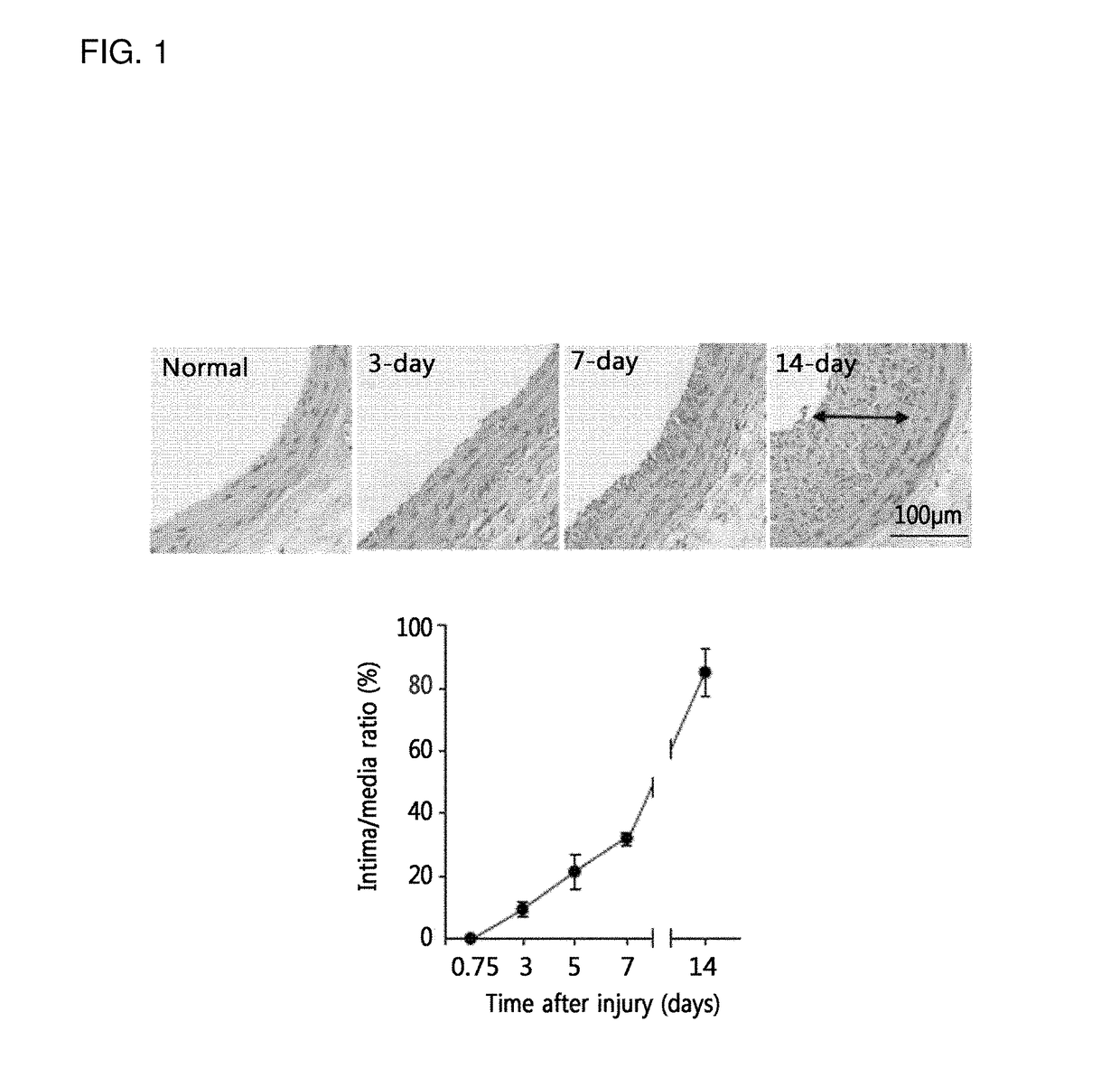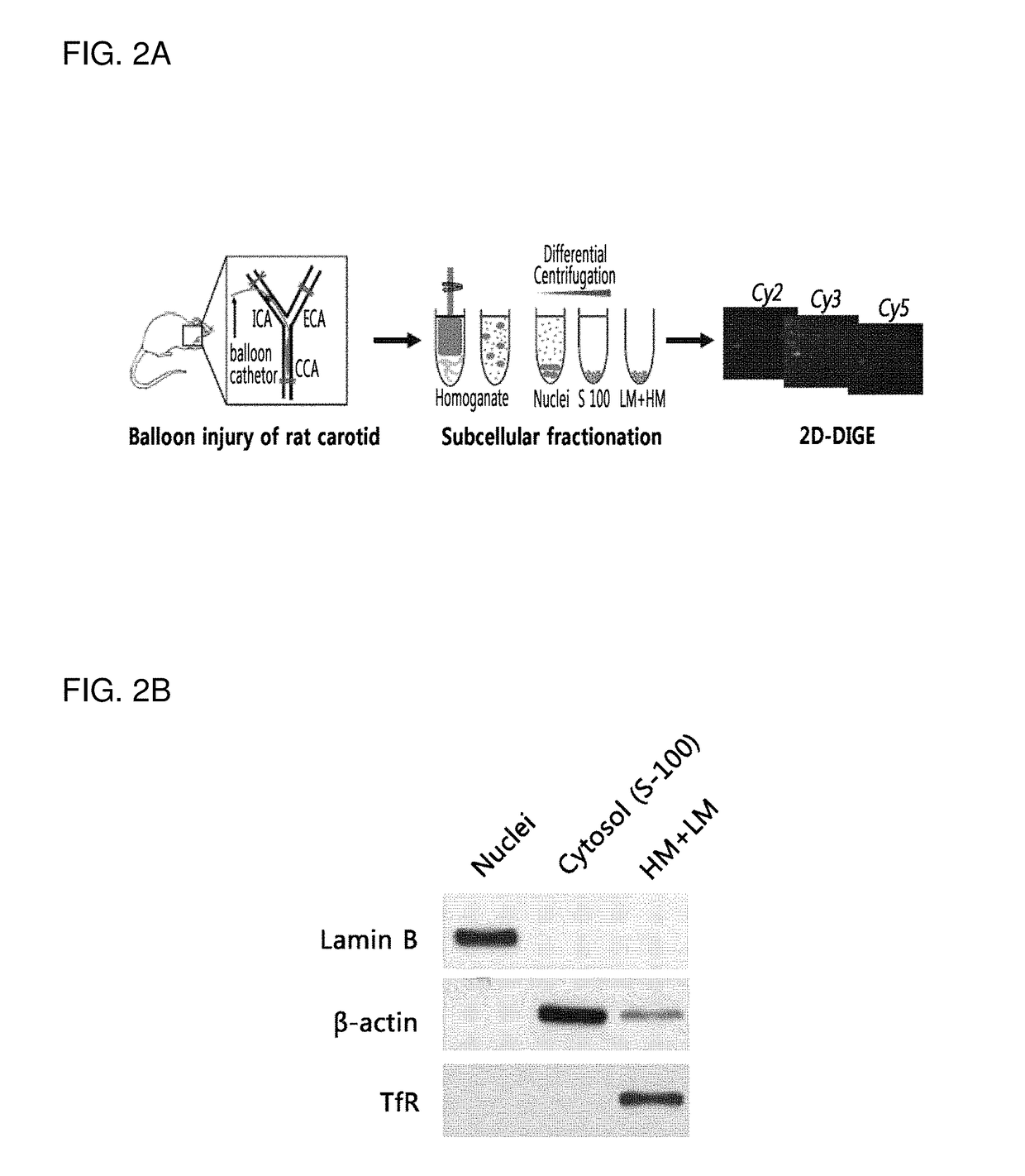Biomarker for diagnosing vascular diseases and the uses thereof
a biomarker and vascular disease technology, applied in the field of composition for diagnosing vascular diseases, can solve the problems of ischemic symptoms or blood clots, inability to easily diagnose intimal thickening, and accompanied inability to stabilize angina,
- Summary
- Abstract
- Description
- Claims
- Application Information
AI Technical Summary
Benefits of technology
Problems solved by technology
Method used
Image
Examples
example 1
on of Balloon-Induced Injury Model of Rat Carotid Artery
[0099]In the present invention, animal studies were performed in compliance with the guidelines of Institutional Animal Care and Use Committee (IACUC) of Ewha Womans University and conformed to “Guide for Care and Use of Laboratory Animals” published by the US National Institutes of Health (The National Academies Press, 8th Edition, 2011).
[0100]In the present invention, ten-week-old male Sprague-Dawley rats were used for a balloon-induced injury model of rat carotid artery, and the balloon-induced injury model of rat carotid artery was prepared as previously described (D H Kang, et al., Circulation 2013; 128:pp 834-844.). First, rats were anesthetized by inhalation of isoflurane gas (N2O:O2 / 70%:30%).
[0101]For proteomics analyses, the rats were recovered in the cages for different time points (18-hr, 3-day, 5-day, and 7-day) after a surgical operation. Each experimental group size was 8 rats and the sham operation was used for z...
example 2
Mediated Intramural Delivery of siRNAs into Carotid Artery
[0103]In order to examine molecular biological changes by delivery of siRNA to injured carotid arteries of the carotid artery-injured animal model prepared in Example 1, catheter-mediated intramural delivery of siRNAs was performed.
[0104]In detail, the rat-specific siRNA SMART pools (GE Healthcare Dharmacon, Cat # M_095069-01, 200 nM) were premixed with siPORTTM NeoFXTM reagent following the manufacturer's instructions (Ambion). Immediately after the balloon injury, the common carotid arteries were washed with Opti-MEM and the transfection premix (200 μl) was administered through the catheter. The vessel was incubated for 15 minutes to allow the efficient transfection and then ligated. A fluorescent dye-conjugated control siRNA named siGLO-Red (Dharmacon) was used for confirming the intramural transfection of siRNA.
example 3
cal Analysis
[0105]For histological analysis, rats were anesthetized by inhalation of isoflurane gas (N2O:O2 / 70%:30%), as described in Example 1, and the common carotid arteries were excised after transcardiac perfusion-fixation with heparinized saline containing 3.7% formaldehyde. The excised carotid arteries were paraffin embedded and sectioned by rotary microtome (Leica RM2255). The two serial tissue sections (4 μm in thickness) were obtained from the middle area of common carotid arteries and stained with haematoxylin and eosin (H&E). The luminal, internal elastic laminal, and external elastic laminal areas were measured using NIH Image v1.62. The intimal and medial areas were determined by subtraction of the luminal area and the external elastic area from the internal elastic area. The values from two serial sections per rat were averaged for analysis.
PUM
| Property | Measurement | Unit |
|---|---|---|
| Length | aaaaa | aaaaa |
| Level | aaaaa | aaaaa |
Abstract
Description
Claims
Application Information
 Login to View More
Login to View More - R&D
- Intellectual Property
- Life Sciences
- Materials
- Tech Scout
- Unparalleled Data Quality
- Higher Quality Content
- 60% Fewer Hallucinations
Browse by: Latest US Patents, China's latest patents, Technical Efficacy Thesaurus, Application Domain, Technology Topic, Popular Technical Reports.
© 2025 PatSnap. All rights reserved.Legal|Privacy policy|Modern Slavery Act Transparency Statement|Sitemap|About US| Contact US: help@patsnap.com



